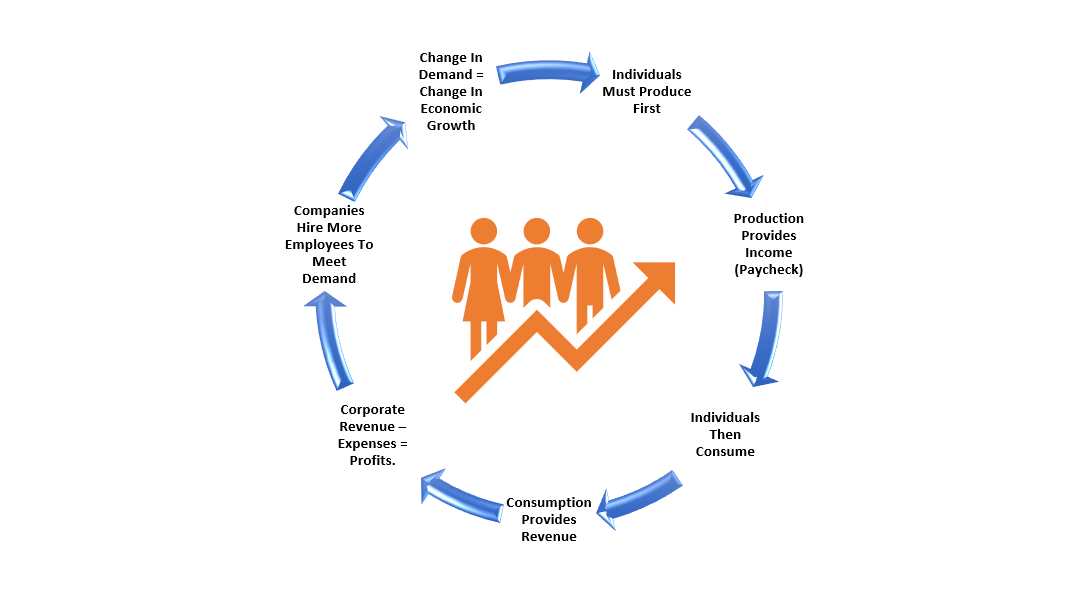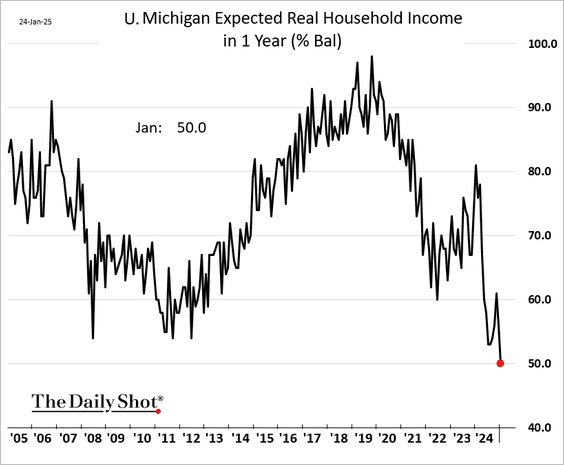Oil prices extend gains on Trump’s Venezuela blockade; weekly losses still likely
The Federal Reserve’s record of forecasting has frequently led it to respond too late to changes in economic and financial conditions. In the most recent FOMC meeting, the Federal Reserve changed its statement to support a pause in the current interest rate-cutting cycle. As noted by Forbes:
“The policy-setting Federal Open Market Committee agreed unanimously to hold the target federal funds rate at 4.25% to 4.5%, the U.S. central bank announced Wednesday afternoon following the conclusion of the FOMC’s two-day meeting. The pause breaks a three-meeting streak of cuts dating back to September, when the Fed rolled out its first rate cut since March 2020.
The FOMC announcement noted unemployment “has stabilized at a low level” and “inflation remains somewhat elevated,” notably removing a reference from its prior rates decision of inflation making “progress” toward the 2% target.”
As a reminder, the Federal Reserve has two official mandates: full employment and price stability. The Fed specifically addressed those two mandates in its announcement to pause rate cuts at the last meeting. Furthermore, those two mandates are crucial to economic stability and, ultimately, the financial system. Full employment and stable inflation should support stronger levels of economic activity, providing stability to the financial system through increased credit use with lower default rates.
However, the Fed’s record of forecasting future economic growth rates is abysmal. The table below tracks the average of the Fed’s economic forecast range from 2011 vs actual GDP.
The obvious problem is that the risk of policy response errors increases when future growth estimates range far from reality (typically during crisis events).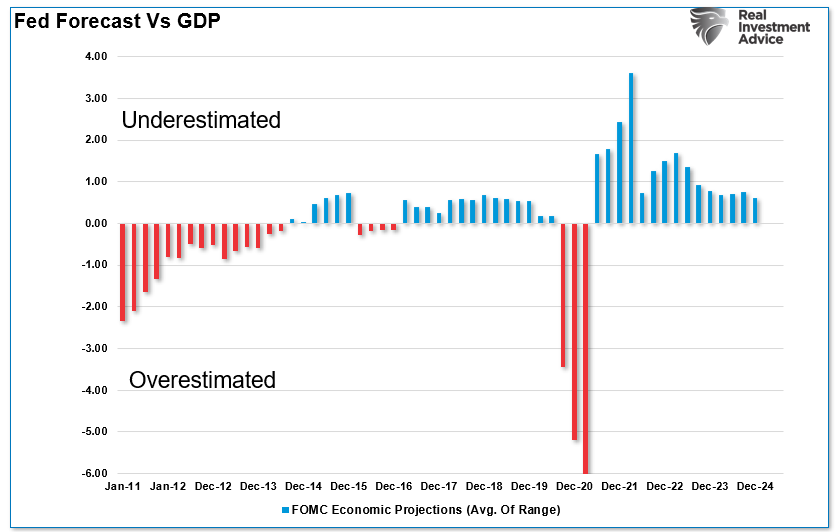
Unexpected Factors
The obvious problem for the Federal Reserve is that forecasting is always problematic due to unexpected events that can disrupt consumer activity. This is particularly the case today, more than in the past, given that consumption is nearly 70% of the U.S. economy. However, it is notable that since 2000, while household debt continues to increase dramatically, it is no longer fueling increases in economic activity.
In other words, households are consuming more debt to sustain their standard of living rather than increasing it, as seen from 1980 to 2000.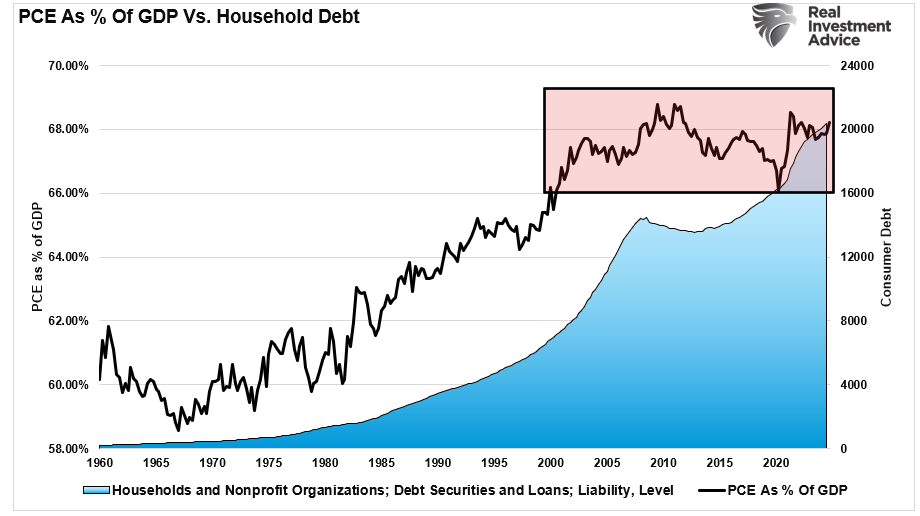
This is a crucial point. The Fed depends on consumer confidence to drive economic activity, which it hopes to achieve through higher asset prices. However, despite higher asset prices, the bottom 90% of the economy struggles to increase consumption as their share of “economic wealth” has not materially increased. Such was a point we made in “Bullish Exuberance Returns:”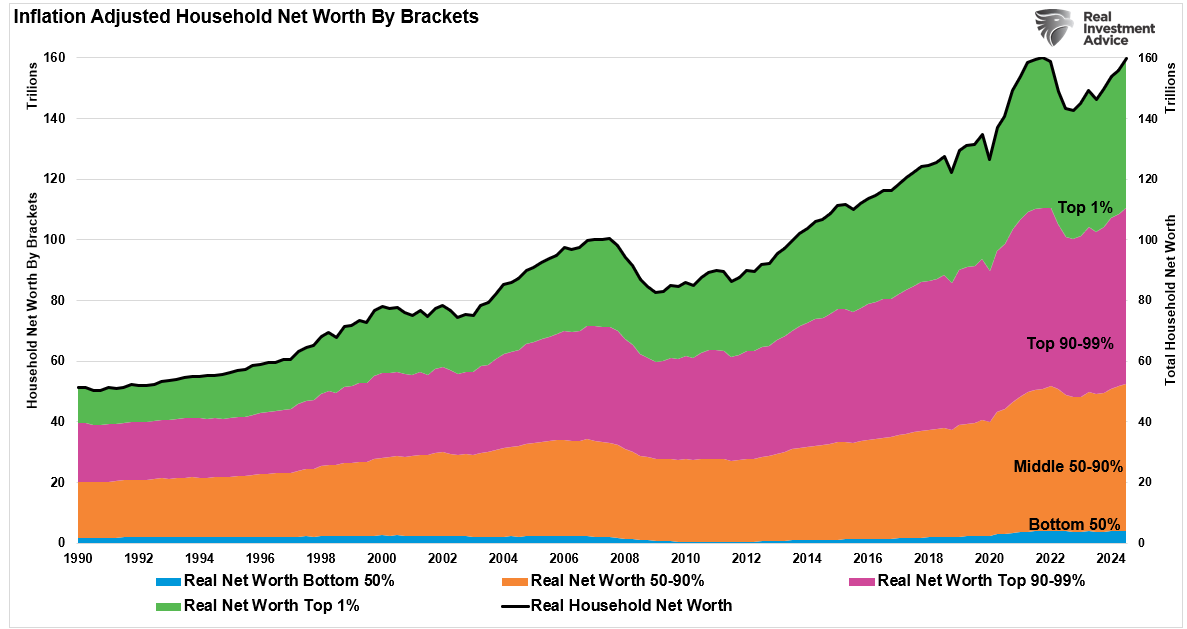
This is why nominal economic growth continues to return toward its long-term 2% growth trend, which will likely fall below that level over the next few years.
Given that debt diverts productive dollars into debt service, such deters stronger economic outcomes across income classes.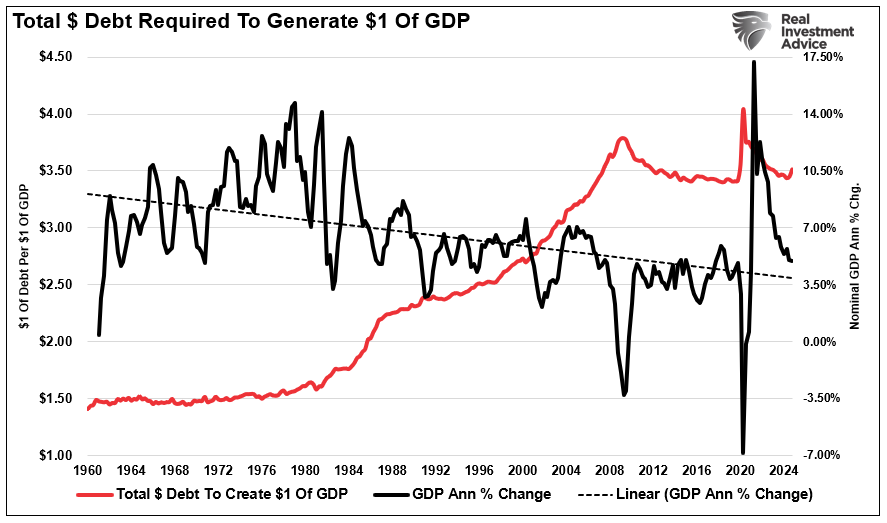
Given that economic growth is a function of economic production and consumption, the inability to expand economic prosperity suggests the Fed’s current forecasts are likely once again overstated. Such is particularly the case with their views on the strength of employment.
Forecasting Errors Lead To Policy Errors
The critical component to expanding economic growth is employment. As we explained in “Labor Market Impact On The Stock Market:”
“While [recent] headline figures seemed decent, the underlying data reveals clear warning signs that worker demand is slowing. Investors should pay attention because the link between employment and its impact on the economy and the market is undeniable. While often overlooked, as we will discuss, there is an undeniable link between economic activity and corporate earnings. Employment is the driver of a consumption-based economy. Consumers must produce first before consuming, so employment is critical to corporate earnings and market valuations.“
The production cycle is crucial to both economic and inflation expectations. Without a strong employment market, increasing organic economic activity is challenged. While increases in government spending can temporarily offset weakness in consumption, the sustainability of that support is challenged as it requires increasing levels of debt to generate the same level of economic activity in the future, as shown above.
Given that employment is the lynchpin of economic growth, the Fed’s current assessment of the labor market’s strength is a significant risk in its forecasting accuracy. Following the most recent FOMC meeting analysts were quick to jump on “employment strength” as the reason to delay further rate cuts.
“This is a new phase of the Fed’s easing cycle, given the strong growth and resilient labor market data providing scope for a more patient approach amid elevated data and policy uncertainty. The Fed’s easing cycle has not yet run its course, but the FOMC will want to see further progress in the inflation data to deliver the next rate cut highlighted by the fact they removed the reference on inflation making progress.” – Lindsay Rosner, Goldman Sachs
However, as the history of Fed rate-cutting cycles shows, the Fed often “reacts“ to economic events that undermined their previous assessments of lagging economic data. In other words, the Fed is almost always “too late” in enacting policy changes.
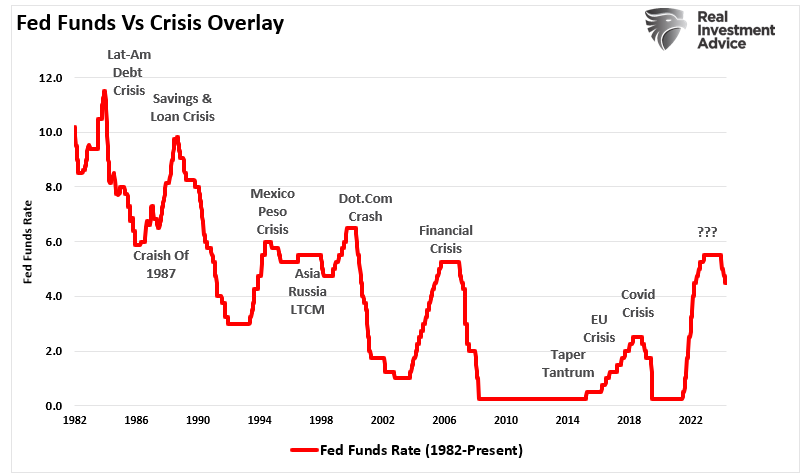
The Real “Employment” Situation
This will likely happen again, as the Fed’s assessment of the labor market’s strength is likely overly optimistic.
“We think the Fed is going to end up being on the wrong side of the forecast. Job gains are far less ‘strong’ than has been characterized in this statement. All these job gains are in part-time employment and hiring rates have absolutely plummeted. The backlog of continuing claims has been on a discernible upward path and the consumer surveys have revealed a substantial loss in labor market confidence.” – David Rosenberg, Rosenberg Research
He is correct. The chart below shows the cumulative change to full-time and part-time labor over the last few years.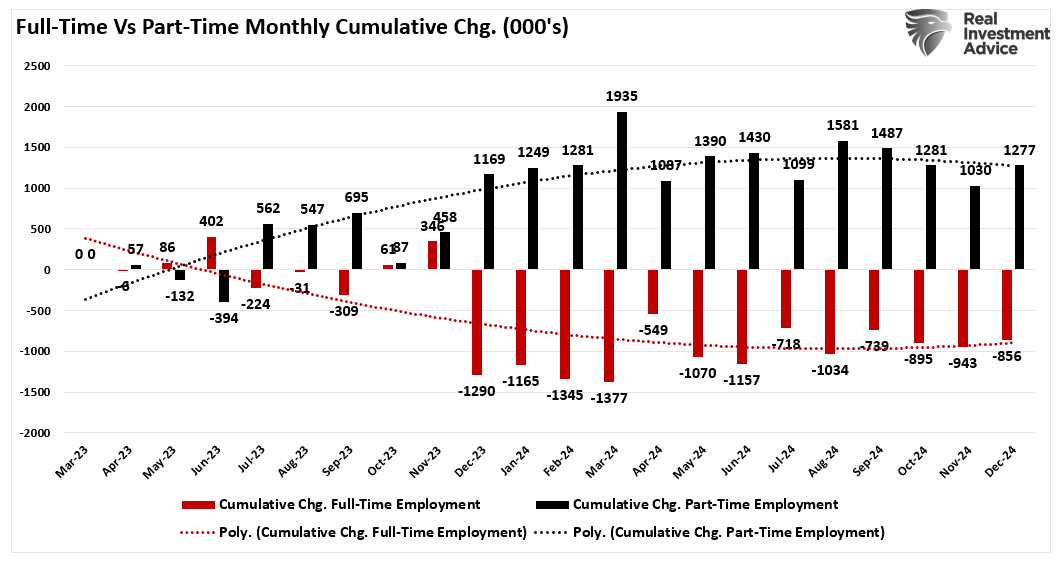
As noted above, employment is required to create consumption and increase economic activity. Crucially, “full-time” employment is required to create stronger economic growth rates, providing higher incomes, benefits, and household stability. Notably, peaks in full-time employment relative to the total number of employed civilians have correlated with weaker future economic outcomes and disinflationary impacts. (The only exception was 2020, as mass employment terminations created a temporary bump in full-time employment.)
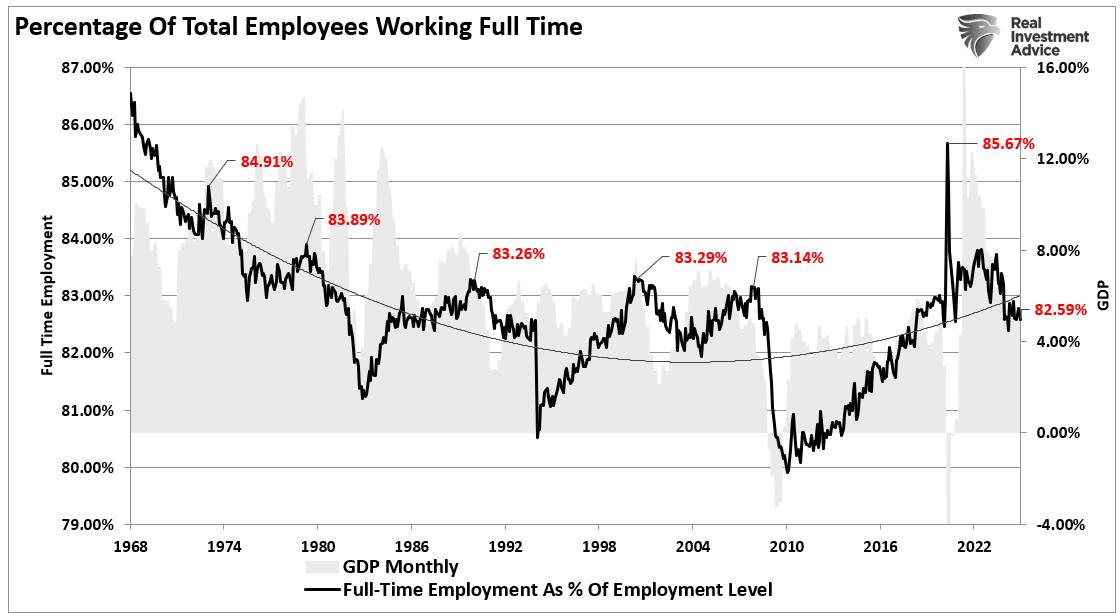
The data supports that last statement. Weaker full-time employment as a percentage of the current employment level correlates to weaker personal consumption expenditures. If the “demand” for goods and services declines, so does inflation.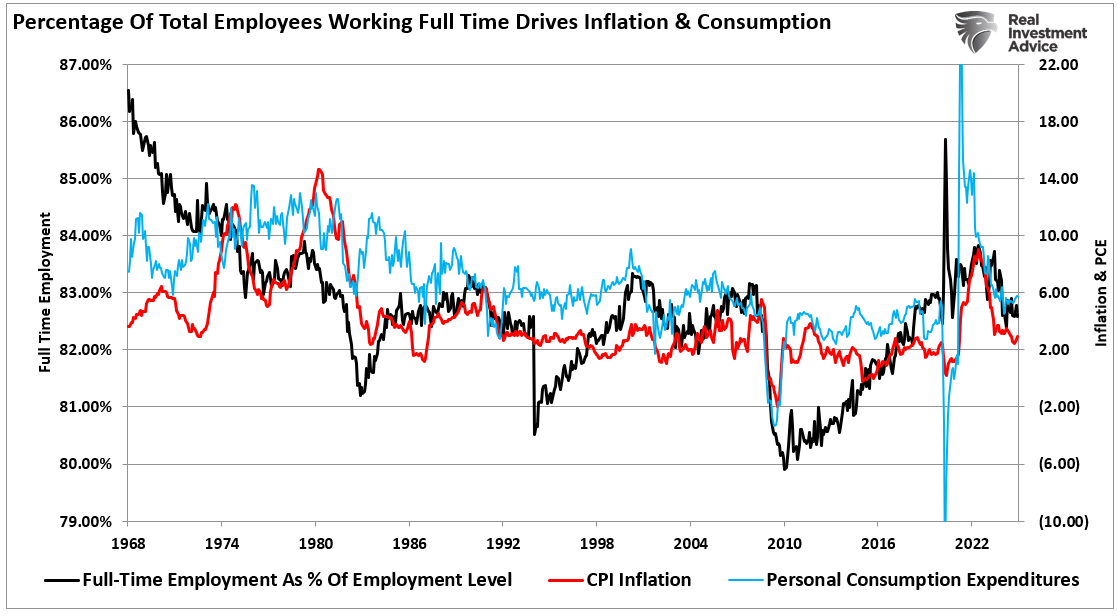
The current “lagging” economic data may support the Fed’s recent pause in rate cuts. However, its forecast of stable employment and inflation may be in error when future data revisions reveal a far weaker situation.
A Familiar Mistep By The Fed
The tendency to rely on past data increases the risk of policy errors. Such can have significant consequences for financial markets, economic growth, and consumer confidence. While current economic data may appear healthy, consumers do not necessarily agree. Such is shown by consumer expectations of incomes over the next year. As Michael Lebowitz commented recently:
” While labor market data is generally good, there are signs the labor market is at a standstill. Continuing jobless claims are steadily rising at their highest level in over three years. The JOLTS hires rate is at ten-year lows. While the number of layoffs remains low, employers aren’t hiring either. Accordingly, the broad labor market data may seem good, but the chart below and other data should give the Fed pause so that consumers may start to spend less and save more. As if the chart below wasn’t concerning. It shows employment expectations are also plummeting. Similar changes in expectations have led to a higher unemployment rate previously.”
The rise in part-time employment, slowing hiring rates, and increased continuing jobless claims indicate a weaker labor market. Historically, overestimating employment strength has led the Fed to delay necessary rate cuts. Once economic conditions deteriorate further, the Fed is forced to reverse course.
Another key issue for the Fed remains higher borrowing costs. As debt burdens rise and wage growth stagnates, consumers increasingly rely on credit to maintain their standard of living. The longer rates remain elevated, the more pressure is applied to disposable incomes. For the Fed, if consumer spending weakens, inflation will decline more sharply than the Fed anticipates. Such will pose risks to future financial and economic stability.
The implications of the Fed’s forecasting errors extend beyond employment and consumption. A delayed policy response can heighten market volatility, disrupt business investment decisions, and exacerbate economic downturns. As history has shown, the Fed often acts too late, reacting to economic deterioration rather than proactively preventing it. Given these risks, investors should remain cautious and prepared for potential shifts in monetary policy that could impact market trends.
Based on current data, the Fed’s decision to pause rate cuts may appear justified. However, future revisions may reveal a far weaker economic backdrop than anticipated. If past patterns persist, the central bank could adjust policies too late.
However, such remains the Fed’s ongoing challenge of accurately forecasting the future.

